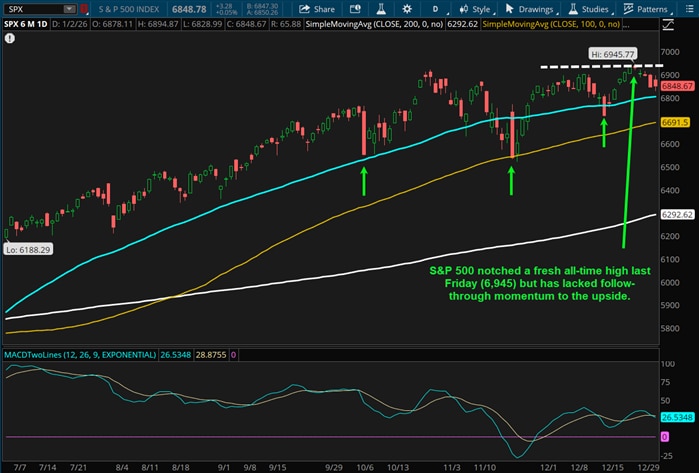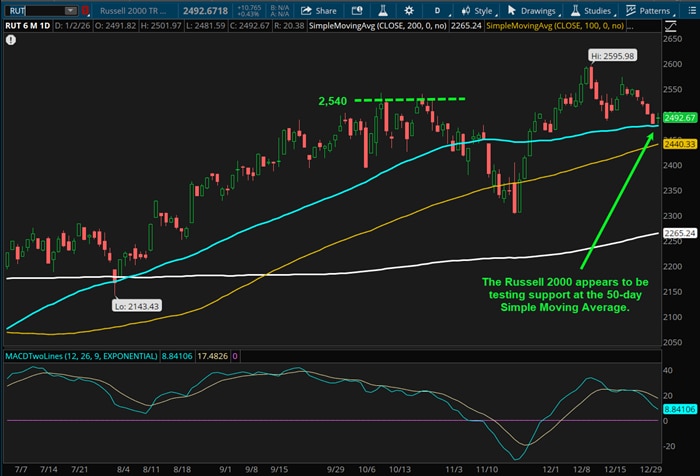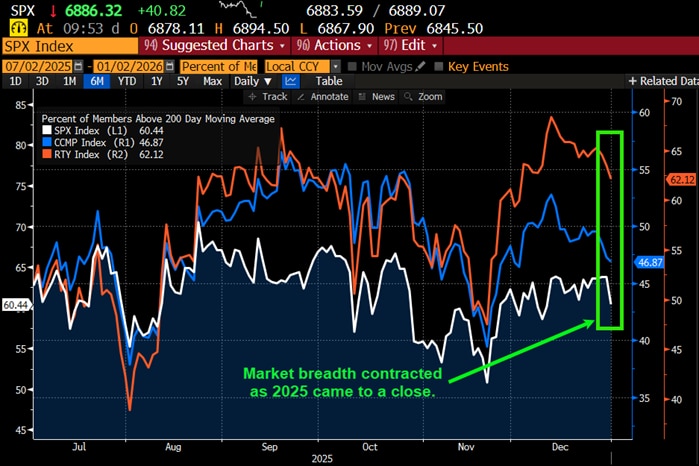Weekly Trader's Outlook
Investors Attempt Bullish Start to the New Year Following Lackluster End to 2025

The Week That Was
If you read the last blog from December 19th, you might recall that my forecast for last week was "Slightly Bullish," citing encouraging technicals on the S&P 500 Equal Weight index (SPXEW) and bullish seasonality. Last week the S&P 500 (SPX) gained 1.25%, and notched fresh all-time highs, but this week the index has essentially given all those gains back. Perhaps this week's pullback is related to year-end tax-loss selling, or the modest rise in longer-term Treasury yields, but it was a lackluster closeout to an otherwise impressive 16% gain in the S&P for 2025. As expected, the volume was relatively light this week, as was the release of economic data, but we did get the release of the Federal Reserve minutes from the December Federal Open Market Committee (FOMC) meeting. The report showed slightly more divisiveness within the Fed, with some members considering putting the policy on hold until the committee receives more data around the labor market and inflation (more on this in the "Economic Data, Rates & the Fed" section below).
Standouts from this first trading day of 2026 include many of the best performing stocks of 2025–Micron Technology (MU + $26.70 to $312.11), SanDisk (SNDK + $31.85 to $269.23), Seagate Technology (STX + $10.29 to $285.68) and Western Digital (WDC + $14.02 to $186.29) are up anywhere between 3-11% today. AI infrastructure plays such as GE Vernova (GEV + $21.43 to $675.00) and Vertiv Holdings (VRT + $12.50 to $174.51) are also catching a bid in today's trading. Chip stocks are also starting the year in the green as the PHLX Semiconductor Index is higher by nearly 4% today. However, it's more of a "select tech" rally today rather than a rising tech tide lifting all boats. Most of the megacap tech complex has moved into the red around midday after a strong opening. While Nvidia and Alphabet are still holding onto modest gains, Amazon.com Inc. (AMZN - $4.67 to $226.16), Apple Inc. (AAPL - $2.02 to $269.84), Meta Platforms (META - $8.39 to $651.70) and Microsoft (MSFT - $11.75 to $471.87). What's caught my technical eye today is MSFT, which is dropping below its 50-day Simple Moving Average (SMA) for the first time since last April. The stock had previously bounced off this moving average in both November and December. Elsewhere, the industrial and material sectors are exhibiting some relative strength today (both up over 1.40% at the time of this writing), but it's clear that it is too early to establish a 2026 theme based on today's trading.
Outlook for Next Week
At the time of this writing (2:30 p.m. ET), stocks are mixed, with relative strength seen in the Dow Jones and Russell 2000 indices, and weakness still seen in the Nasdaq (DJI + 259, RUT + 20, SPX + 8, $COMP - 12). Longer-term treasury yields are also creeping higher and are worth monitoring next week as the 10-year Treasury yield is just below 4.20% and the 30-year Treasury yield (4.872%) is up to three-month highs. The creep higher in longer-term yields isn't necessarily bearish for stocks, but it can introduce some additional volatility, especially for rate-sensitive sectors. If yields continue to push higher in the coming weeks, but it's driven by longer-term economic growth expectations, investors will likely be forgiving of the development. Speaking of the economy, next week we'll get the ADP report, JOLTs and Nonfarm Payrolls report, all of which will help color the picture of the U.S. labor market and potentially add volatility to trading. The technical backdrop is mostly positive, with the Russell 2000 appearing to be bouncing off support at its 50-day SMA today, and that's despite a creep higher in yields. The first week of trading can be a bit tricky to assess as conflicting forces can be at play–the January Effect (fresh capital being put to work), capital gain selling by investors waiting on the New Year to postpone taxes and potential rotation into underperforming sectors ("Dogs of the Dow" theory). I'm also not sure how resilient the bulls can be should Treasury yields continue to push higher. However, stocks are staging a late-day recovery at the time of this writing, and today's ~1% bounce in the RUT looks encouraging from a near-term perspective. Therefore, I'm providing an overall "Moderately Bullish" forecast for next week. What could challenge my forecast? If next week's employment data significantly misses estimates to the downside this could cloud the economic outlook a bit and lead to a down week for stocks.
Other Potential Market-Moving Catalysts
Economic:
- Monday (Jan. 5): ISM Manufacturing Index
- Tuesday (Jan. 6): no reports
- Wednesday (Jan. 7): ADP Employment Change, Business Inventories, EIA Crude Oil Inventories, Factory Orders, ISM Non-Manufacturing Index, JOLTs – Job Openings, MBA Mortgage Applications Index
- Thursday (Jan. 8): Consumer Credit, Continuing Claims, EIA Natural Gas Inventories, Initial Claims, Productivity – Preliminary, Trade Balance, Unit Labor Costs – Preliminary, Wholesale Inventories
- Friday (Jan. 9): Average Workweek, Building Permits, Hourly Earnings, Housing Starts, Nonfarm Payrolls, Unemployment Rate, University of Michigan Consumer Sentiment
Earnings:
- Monday (Jan. 5): no reports
- Tuesday (Jan. 6): AngioDynamics Inc. (ANGO), Waldencast PLC (WALD), AAR corp. (AIR), Penguin Solutions Inc. (PENG)
- Wednesday (Jan. 7): Albertsons Companies Inc. (ACI), Applied Digital Corp. (APLD), Apogee Enterprises Inc. (APOG), AZZ Inc. (AZZ), Cal-Maine Foods Inc. (CALM), Constellation Brands Inc. (STZ), Jefferies Financial Group Inc. (JEF), MSC Industrial Direct Co. (MSM), PriceSmart Inc. (PSMT)
- Thursday (Jan. 8): Acuity Inc. (AYI), Aehr Test Systems (AEHR), Commercial Metals Co. (CMC), Greenbrier Companies Inc. (GBX), Lindsay Corp. (LNN), RPM International Inc. (RPM), TD Synnex Corp. (SNX)
- Friday (Jan. 9): Anixa Biosciences Inc. (ANIX)
Economic Data, Rates & the Fed
There was a relatively small batch of economic data for investors to digest this week, highlighted by the release of the minutes from the December FOMC meeting. The minutes essentially conveyed a less unanimous vote on the announced 25-basis-point cut, driven by debate over the need to support labor market weakness versus concerns over elevated inflation. There were a total of three dissents on the decision, up from two in October, which represents the most dissents since 2019. Elsewhere, weekly Initial Claims came in well below estimates, which may have been impacted by seasonal influences, but more broadly conveys the recent theme of a "low hire, low fire" labor market environment. Here's the breakdown from this week's reports:
- FOMC Minutes: The minutes from the December 9-10th FOMC meeting revealed continued dissent among committee members. In the 9-3 vote in favor of the 25-basis-point reduction in the fed funds rate, while the consensus expectation is that the economy will expand at a moderate pace, some officials expressed downside risks to the labor market and upside risks to inflation. As a result, some members felt it would be appropriate to keep the target range unchanged for some time after the December rate cut.
- S&P Global U.S. Manufacturing PMI – Final: 51.8 vs. 51.7 est.
- Pending Home Sales: 3.3% vs. 1.1% est.
- Chicago PMI: 43.5 vs. 41.0 est.
- FHFA Housing Price Index: 0.4% vs. 0.1% est
- S&P Case-Shiller Home Price Index: 1.3% vs. 1.2% est.
- Initial Jobless Claims: Initial applications for U.S. jobless benefits dropped 16K from last week to 199K, which was well below the 222K economists had expected. Continuing Claims dropped to 1.866M from 1.913M week-over-week but were below the 1.93M estimate.
- EIA Crude Oil Inventories: +1.93M barrels
- EIA Natural Gas Inventories: -166 bcf
- The Atlanta Fed's GDPNow "nowcast" for Q4 GDP remains unchanged from December 23rd at 3.0%
U.S. Treasury yields Compared to last Friday, two-year Treasury yields are down ~1 basis point (3.473% vs. 3.483%), while 10-year yields are higher by ~4 basis points (4.171% vs. 4.136%), as well as 30-year yields (4.864% vs. 4.82%).
Market expectations for rate cuts from the Federal Reserve backed off over the past week, perhaps due in part to this week's release of the December Fed minutes. Per Bloomberg, the probability of a 25-basis-point cut from the Fed over the next three FOMC meetings are all lower–January is currently 15% vs. 20%, March eased to 54% from 58%, and April is down to 77% from 84%. Historically, the Fed has adjusted policy when the probability has been roughly 65% or greater, which suggests that markets currently believe that the next rate cut will be at the April FOMC meeting.
Technical Take
S&P 500 Index (SPX + 4 to 6,848)
Last week the S&P 500 index (SPX) finally notched a fresh all-time closing high, surpassing its prior all-time high of 6,920 from back on October 29th, but failed to garner any follow-through momentum to the upside this week. In fact, the SPX is on track to be down over 1% this week and is currently just over 0.5% above its 50-day Simple Moving Average (SMA) of 6,804. Although the new all-time high is bullish, and the longer-term trend remains in a bullish uptrend, on a near-term basis the lack of follow-through conviction may suggest additional sideways consolidation may be needed before trend can be established. The narrowing gap between the 100-day SMA and 50-day SMA over the past four months reflects this. Therefore, the near-term technical assessment is neutral in my view, with near-term support a the 50-day SMA (6,804) and near-term resistance at the prior all-time high (6,945, or 6,929 on a closing basis).
Near-term technical translation: neutral

Source: ThinkorSwim trading platform
Past performance is no guarantee of future results.
Russell 2000 Index (RUT + 10 to 2,492)
Back on December 19th, I expressed a "cautious" technical outlook on the Russell 2000 index (RUT) unless/until the index moved back above its prior all-time high around 2,540. The index subsequently attempted to push above this level but appears to have rolled over, on track to be down ~1.6% this week. While the potential for the "broadening trade" to gain traction in 2026 remains a potential, I believe the creep higher in long-term rates is holding this rate-sensitive index back. Yields on U.S. 30-year Treasuries are currently at 4.864%, representing the highest level since early September. In terms of the near-term technicals, if the RUT can hold ground above its 50-day SMA (2,476) the outlook is bullish but would flip to bearish if it were to fall below this indicator, so it's at a bit of an inflection point currently.
Near-term technical translation: bullish if above 50-day SMA (2,476), bearish below this level

Source: ThinkorSwim trading platform
Past performance is no guarantee of future results.
Cryptocurrency News
In a New Year's Day post on social media platform X, Ethereum co-founder Vitalik Buterin applauded the technical progress the Ethereum network achieved over the year but expressed the need to remain focused on not just technical milestones, but his longer-term vision for Ethereum: "To build the world computer that serves as a central infrastructure piece of a more free and open internet." To succeed at this, Buterin said Ethereum: a) needs to be usable, and usable at scale, and b) actually decentralized. He added that these objectives must be accomplished at both "the blockchain, including the software we use to run and talk to the blockchain and the application layer." Buterin pointed at applications built on top of the network which can lock users into subscription-based centralized platforms, despite using decentralized protocols. "Ethereum is the rebellion against this," he wrote. While Buterin did not lay out a specific roadmap to accomplish stated goals, he remains optimistic about the potential to accomplish his goal to establish Ethereum as a "world computer." Ethereum's native token Ether (ETH + 142.77 to 3,143.01) declined roughly 6% in 2025 after hitting a high near $4,900 back in August.
Market Breadth
The Bloomberg chart below shows the current percentage of members within the S&P 500 (SPX), Nasdaq Composite (CCMP), and Russell 2000 (RTY) that are trading above their respective 200-day Simple Moving Averages (SMA). In short, stocks are on track for weekly losses and market breadth contracted modestly as a result. Compared to last Friday's, the SPX (white line) breadth declined to 60.44% from 63.58%, the CCMP (blue line) dropped to 46.87% from 49.55%, and the RTY (red line) ticked down to 62.12% from 63.65%.

Source: Bloomberg L.P.
Market breadth attempts to capture individual stock participation within an overall index, which can help convey underlying strength or weakness of a move or trend. Typically, broader participation suggests healthy investor sentiment and supportive technicals. There are many data points to help convey market breadth, such as advancing vs. declining issues, percentage of stocks within an index that are above or below a longer-term moving average, or new highs vs. new lows.
This Week's Notable 52-week Highs (81 today): Alcoa Corp. (AA + $1.26 to $54.40), Axsome Therapeutics Inc. (AXSM - $4.11 to $178.53), Exxon Mobil Corp. (XOM - $0.44 to $119.90), FTAI Aviation Ltd. (FTAI + $4.28 to $201.13), LightPath Technologies Inc. (LPTH - $0.10 to $10.70), Micron Technology Inc. (MU + $20.75 to $306.23)
This Week's Notable 52-week Lows (77 today): Autohome Inc. (ATHM + $0.53 to $22.79), Cracker Barrel Inc. (CBRL - $0.29 to $25.11), Janux Therapeutics Inc. (JANX - $0.07 to $13.73), Lucid Group Inc. (LCID + $0.37 to $10.94), Semler Scientific Inc. (SMLR + $0.52 to $15.81), Tenable Holdings Inc. (TENB - $0.14 to $23.39)